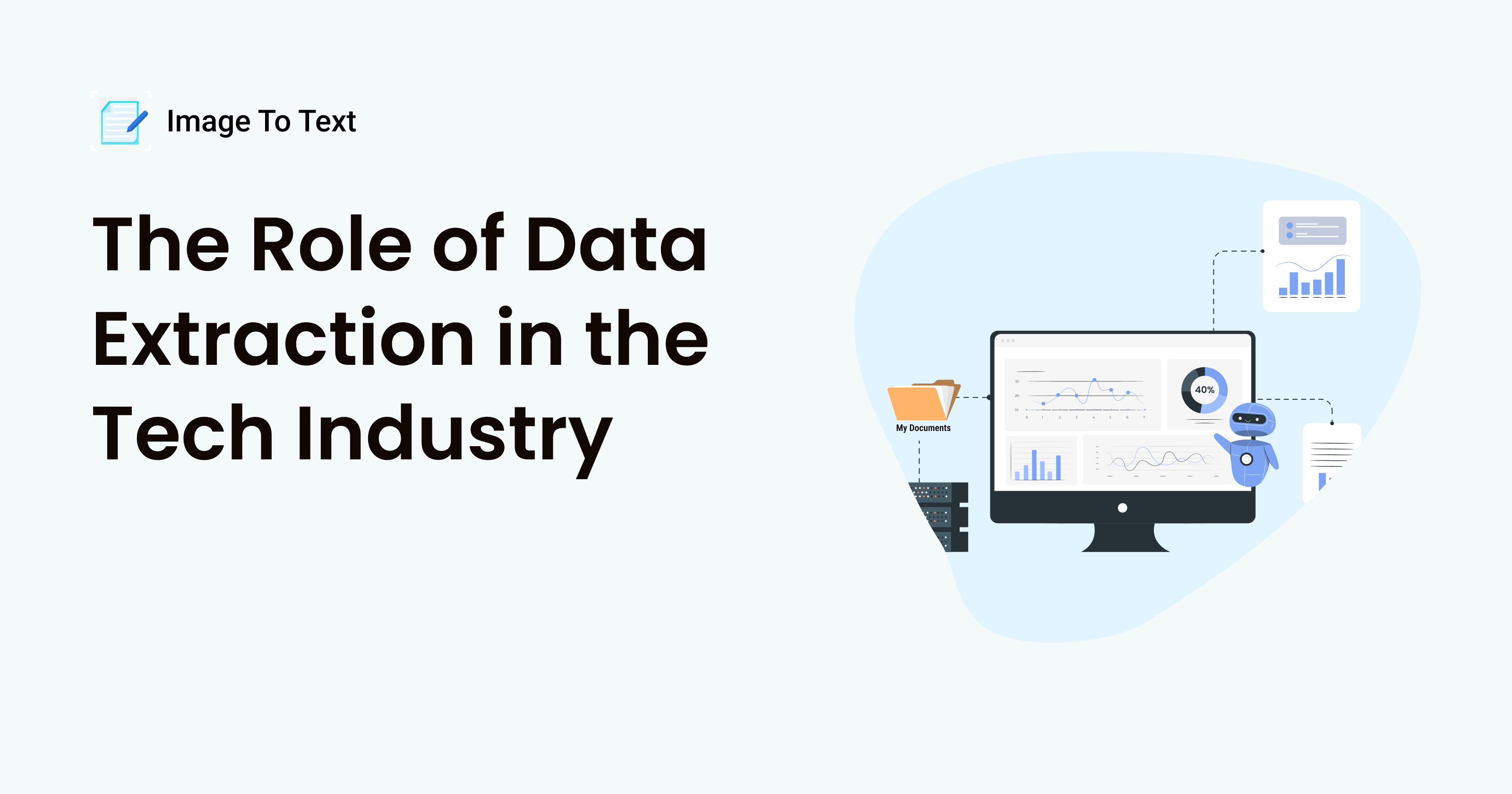The Role of Data Extraction in the Tech Industry
The tech industry is becoming more and more data-driven as time passes. They rely on information of various sorts to move forward with their functioning. However, as this reliance on data increases, the amount of data available also increases.
This can reach a point where even a good number of trained workers can’t process the information by themselves. Think about it yourself. If a company receives a thousand emails every day, can they all be read and dealt with in time?
This is the reason why automation and automated data extraction have become so important these days. This article will provide insights into this matter. With the help of this write-up, you will understand what data extraction is and why it is so important.
What is Data Extraction?
Data Extraction involves retrieving data from various, usually unorganized, sources so that it can be converted into usable information. These sources can vary greatly as they can be emails, documents, databases, hard copies, and much more.
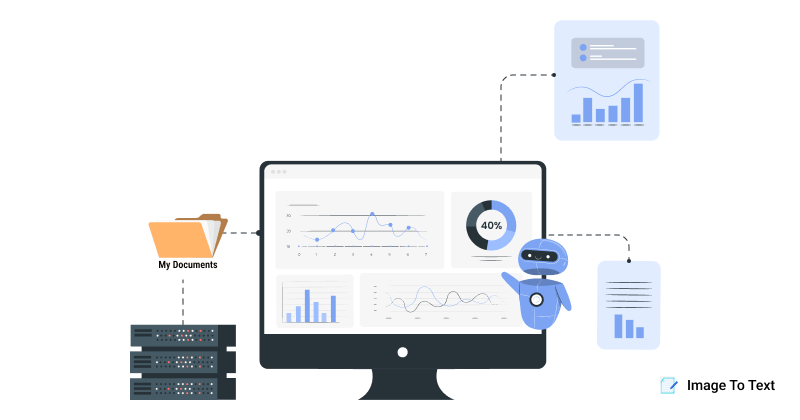
But what do we mean by unorganized sources or usable information? Let us paint a scenario to help you understand better. Suppose a clothing brand receives a large number of customer surveys. This data, which is in the form of various documents that show what each customer has selected, can be called unstructured data.
However, once these documents are analyzed, the store can create a report that shows things like the percentage of satisfied and unsatisfied customers, most liked items, delivery satisfaction percentage, etc. This is useful and structured information. So, the process by which the data from surveys was converted into analytical insights is termed data extraction.
What is Automated Data Extraction?
In the previous example, we can go about data extraction in two ways. One is the manual method, and the other is an automatic one. Both of these are explained below:
- Manual: The manual method to approach this situation would be that each survey is analyzed separately by a person. They will go through the files to see which options the customers have selected and make an Excel file that presents this data in processed form.
- Automatic: The automated method can do the above task with minimal human interaction. All one has to do is gather the survey documents and feed them into an extraction software. The software will process the data and give the same finalized result.
The manual method can be used when the raw data is not that huge. For example, if the survey was done by 5 or 10 customers, it would be no harm to go over them manually. But what if 200 customers take the survey? It would take days to organize data from the results.
Therefore, the second method is better. Additionally, with the recent rise of AI, data extraction software is better than ever. It uses the latest NLP, ML, and sentiment analysis algorithms to analyze all sorts of raw materials. This means that even if customer feedback is written in normal language, the tools will be able to understand it.
Key Roles of Data Extraction in Tech Industry
An online source reveals that the global data extraction market, valued at $2.14 billion in 2019, is expected to grow to $4.90 billion by 2027, with a compound annual growth rate (CAGR) of 11.8% from 2020 to 2027. This shows the importance of data extraction with the help of proven figures.
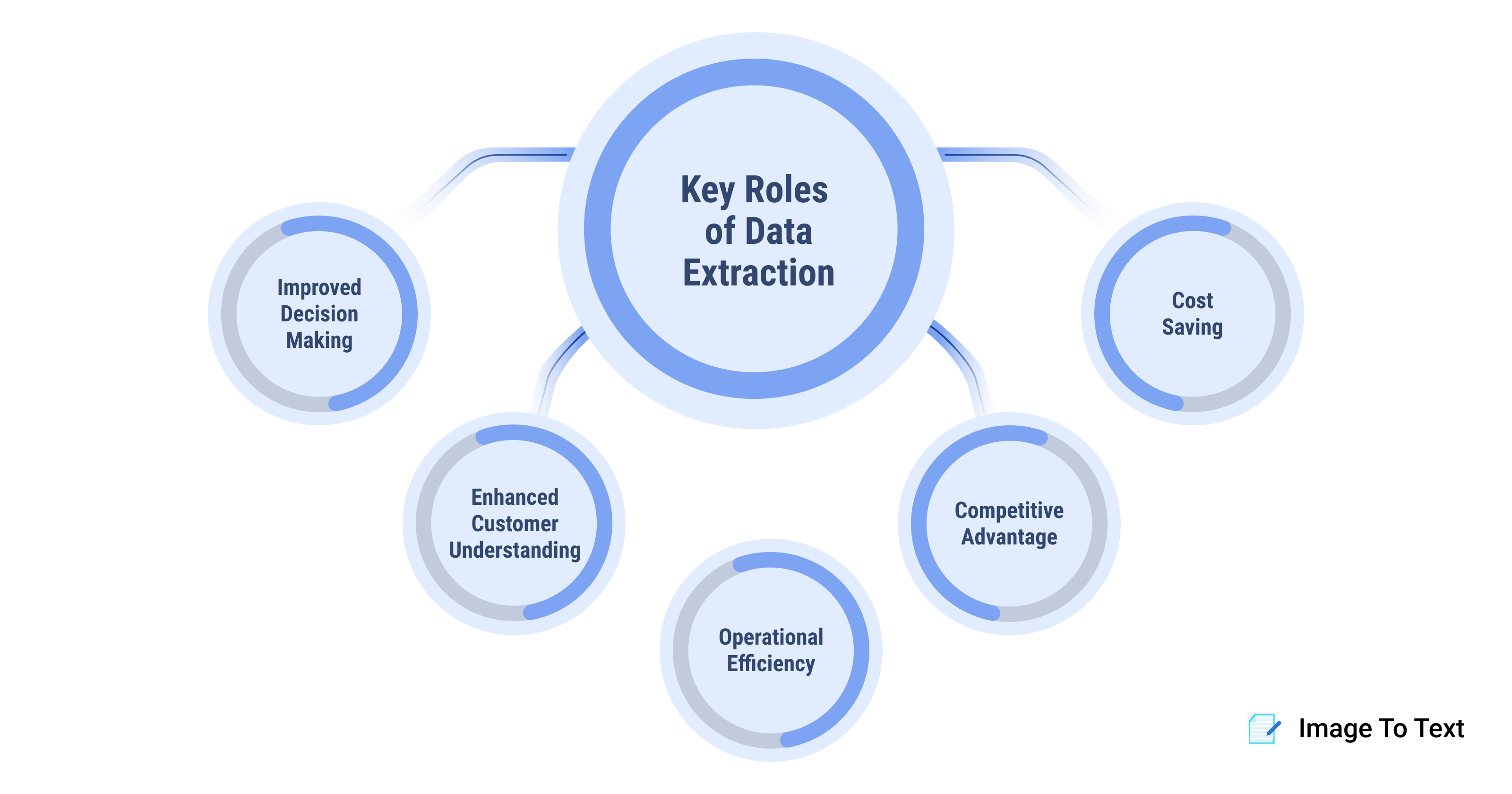
However, for your satisfaction, we will discuss some of the key benefits of integrating effective data extraction in your workflows in this section. This will help you further realize how essential this process is to the tech industry.
1. Improved Decision Making
When we are working with manual data extraction, we come up with decisions on our own by processing raw data. In other words, we have to undergo intense brainstorming to reach a feasible business decision. In the tech industry especially, this poses challenges because of the shortage of time.
If we perform data extraction, we are given loads of ideas as a starting point. Usually, these automated ideas are enough to continue with our work. But if you find the need to brainstorm further, you can use the extracted results as a base. This way, it is much easier to come to conclusions as compared to working it all yourself.
Moreover, this is also helpful in predictive analysis. Technical firms can’t just rely on what is happening right now. They also have to be mindful of the times that are yet to come. AI-enabled data extraction can help in this regard, as it can use data to predict future behaviors.
2. Enhanced Customer Understanding
We have gone into detail about this point in our above-discussed example of data extraction. However, we must re-emphasize this as it has immense potential to improve customer retention. In the context of tech-related companies, customer behavior is important as they usually provide services directly to them.
With data extraction, you can analyze things such as:
- Click Tracking
- Customer Preferences
- Customer Complaints
- User Feedback
- Demographics of Repeating Customers
- Traffic Source
And much more. All of this can be done via impactful data extraction. For example, analysis tools such as Google Analytics can give you insights about where users usually click on your website. It can also help you understand the source from where your customer base is coming. Data such as this can be used to make user experience exponentially better and retain them.
3. Operational Efficiency
We have also hinted at this throughout the article. However, let us explain what we mean by operational efficiency here. Suppose that you have a team that gathers data. Other than that, you have other teams that organize that data and analyze it separately.
After this analysis is done by 3 different departments, it is sent to the operational department to implement various ideas. In contrast, if you have adept automated data extraction systems, you can skip the intermediary steps. You will simply automate the analysis, proofread it briefly, and send it to the relevant department.
This process is much faster and helps break down the traditional hierarchical systems found in industries. For tech companies, this is especially important because they are the epitome of modern functionality.
4. Competitive Advantage
Even though data extraction is highly important and hot these days, not everyone has implied it properly. This opens up the opportunity for you to gain an advantage over your competitors and maybe even redirect their customers your way.
Data extraction isn’t restricted to your company’s own data. You can also extract data from the web. If you are careful with this, you can get the latest information about emerging trends and apply them before anyone else. In other words, proficient data extraction can transform you from an industry follower to an industry leader.
You can also react quickly to any market changes with proper data extraction.
5. Cost Savings
As we have already established, data extraction is a substitute for extensive manual labor. This shows that if this process is applied and integrated into a workspace, the need for a huge workforce won’t be necessary anymore. This can be a medium for substantial cost savings.
A job that costs the salaries of a whole department can now be dealt with just one person’s abilities. This saved money can be invested in other avenues that allow the growth of a company in multiple domains.
Such multifaceted growth can be greatly useful for all sorts of businesses, especially tech startups because their field has now become highly competitive. This is why you should minimize workload and maximize productivity using automated data extraction.
Challenges in Data Extraction
Data Extraction’s innumerable benefits aren’t just there for grabs. There are also some challenges that you may face. We will share them here so you can be prepared beforehand and handle these challenges in a better way.
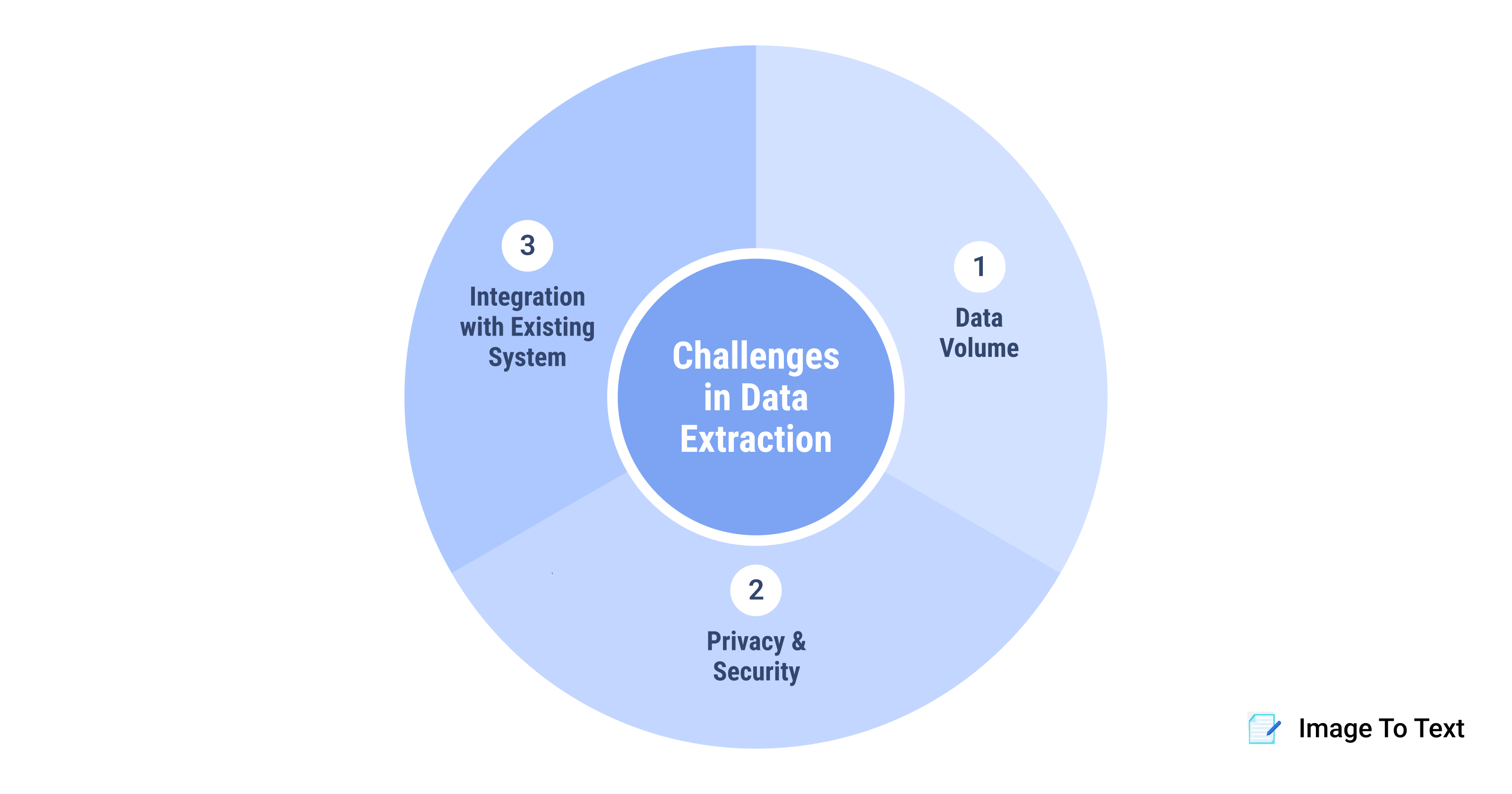
1. Data Volume
Technically, data extraction can be performed on all types of data, even if it is in large amounts. However, as the volume of the data expands, concerns for accuracy also increase. This means that if you input 100 emails into a tool for analysis, it will be easier for the tool to perform its function than if you input 1000.
To handle this issue, you should choose the tool wisely. Not all data extraction tools are built to handle huge amounts of information. So, we suggest that you gauge your workload before integrating a tool into your functions.
This also provides an alternative viewpoint. This is because if you function with a minimal amount of data, it might be a better idea to invest in relatively cheaper software. A top-notch utility won’t be utilized to its full potential in such a case.
2. Privacy and Security
Most of the data extraction tools are credible and trustworthy even for highly sensitive data. However, if we talk about online tools, there always lingers a threat of data theft or an external breach. This issue, however, exists in a very small number of platforms.
Let us list some of the credible tools here:
- Azure AI Document Intelligence
- Google Document AI
- Image to Text
- ABBYY
These are all automation utilities that can help you perform effective data extraction. They have high-security mechanisms that protect your data against any external and internal threats.
If you are interested in using a tool other than these, you can simply read their terms and conditions page and look for credible security systems. If they don’t mention any such thing, it might be a good idea to not use the tool.
3. Integration With Existing Systems
If your current functioning is rather old-fashioned, it can be quite hard to integrate new data extraction systems. For example, if you are still relying heavily on paper-based documents, it will be hard for you to use a data extraction tool.
In this scenario, you will have to convert all the hard copies using a text extraction tool and then process the gathered information. We will talk about this in the upcoming section in detail. However, our point is that setting up a data extraction system might be a hassle.
You can minimize this problem by selecting a tool that fits well with your workflow. However, if you are still finding it troublesome, don’t worry. This short-term hassle will translate into long-term benefits. So, just think that when it’s over, you will be in a better position.
AI + OCR - Modern Solution for Data Extraction
One of the leading technologies in the data extraction industry is OCR. It stands for Optical Character Recognition and is a technology that allows users to extract content from sources that otherwise don’t allow it.
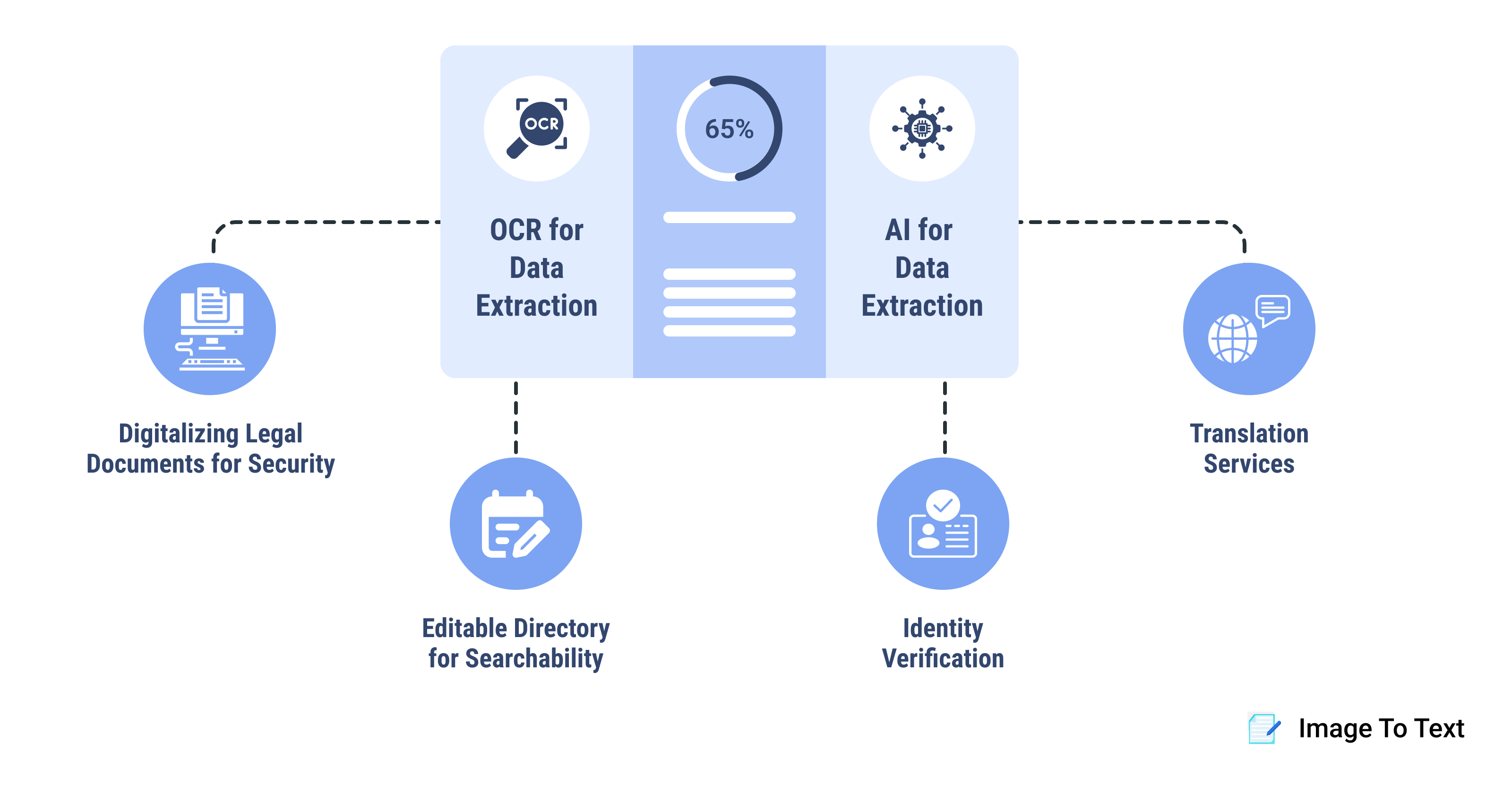
For example, you can’t edit information present inside a PDF or an image directly. With OCR, this is possible. Our main focus is this technology’s relation to data extraction. As we explained a little bit earlier, one of its main uses is document digitalization.
Before we get into details about this, here is a brief overview of how to use an OCR tool:
- On the OCR tool’s webpage, look for allowed upload options. Use one of them to upload relevant documents/images.
- Once your image is uploaded, click on ‘Convert.’
- Some tools might require captcha verification after this step. If that’s the case, click on the checkbox.
- After that’s done, the tool will start processing your image. After a few seconds, your results will be fetched in the form of editable text.
- To collect this text, click on ‘Copy’ or ‘Download.’
The above-mentioned process is one of the most basic examples of data extraction. This method, as you know, uses OCR. To develop this information’s relevance, let’s see how the tech industry can utilize OCR for data extraction.
1. Digitizing Legal Documents for Security
Modern businesses keep their databases digital for the most part. However, they still might have some physical copies lying around. For example, they may have receipts, shareholder arguments, leases, permits, licenses, that are still in their physical form.
These, as you may know, are all greatly important tools. Without them, companies can often get in trouble. This goes the same for tech companies. In order to make such documents more protected, tech firms can use OCR. They can take scanned images of the documents and save them as editable documents.
2. Editable Directory for Searchability
If your database is physical or in the form of PDFs, you can use OCR to convert them into editable Word documents. The purpose of this is better searchability. You might think that you can simply remember the titles of all the documents. However, that might result in you wasting time thinking about what a document was saved as searching for it.
In contrast, if you save content as editable files, you can literally search for anything that was in the file, and the system will fetch it for you. This might be minor, but it saves major time when looked at in the long run. To put this into perspective, here is a statistic for you: On average, an employee spends 2 hours every day searching for documents. You can save at least 1.5 out of these 2 hours every day with an editable database. Think about the productivity boost you can get with this.
3. Identity Verification
This is not an application of this technology that directly affects the working of tech businesses. However, since these companies have high-security standards, we found it important to mention them. With OCR-run systems, they can set up ID verification mechanisms. In this way, only authorized personnel with relevant ID cards will be allowed to enter and access the firm’s data.
Data Entry
A similar application of OCR-based data extraction is automated data entry and processing. For example, you can automatically extract information from invoices, receipts, bank statements, etc., and input them into relevant software. This is easily possible with OCR tools.
4. Translation Services
This point is specifically for international tech firms. This is because sometimes they may have to deal with files in other languages. This is no problem if the said file is in an uneditable format. However, if it is an image, PDF, or any other scanned document, they can’t translate it directly.
In such a case, these firms can use OCR systems. Also, for this, you might not need advanced OCR tools. You can simply use online tools to extract the foreign language and put it directly into translation software.
Conclusion
Tech Industries that are navigating an ever-ending sea of data have an indispensable need for adept data extraction tools. Manual data handling is not feasible at a scale these days. This only leaves us with automated solutions, as explained in this write-up.
Decision-making, customer understanding, and operational efficiency are just the advantages that we have mentioned in this article. As you work with these systems, you will find out many more benefits of this system. This, paired with OCR integration, can make your life much easier.
In conclusion, effective data extraction is essential for tech companies to stay competitive in a data-driven world. Using advanced tools and technologies, businesses can fully utilize their data, fostering innovation and growth in a complex market.
